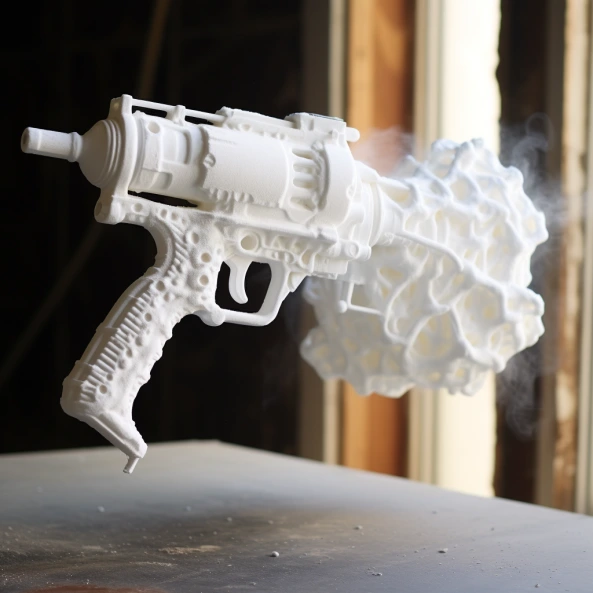Note: This article is specifically for high pressure spray foam guns, and not related to the DIY kits.
Spray foam guns are mighty tools for insulating, sealing and bonding, but only if you care for them properly. Leaving these guns crusted in old foam residue leads to clogging and malfunctions. With the right methods and materials, cleaning your foam gun can be quick and hassle-free.
Foam Gun Gunk Happens
It’s no surprise spray foam guns get grimy quickly:
- Foam reacts and expands rapidly, sticking to any surfaces.
- Chemical components can crystallize and solidify with exposure.
- Mixed foam leftover in the gun continues reacting and hardening.
- Changing foam types leads to cross-contamination.
Not cleaning thoroughly after foam sessions means return visits from the dreaded clog demon.
Equipment for Effective Foam Gun Cleaning
Arm yourself with these cleaning supplies:
- Paint brush – for scraping off chunks.
- Rags – disposable shop towels work well.
- Bucket/trash can – for catching foam residue.
- Solvents – acetone or mineral spirits.
- Lubricating oil/grease.
- Eye protection & gloves!
Step-By-Step Foam Gun Cleaning
Follow this process for keeping guns crud-free:
1. Relieve the Pressure
Open the gun’s relief valve after use. This releases any remaining pressure and vents chemical gases.
2. Remove Excess Foam
Pick out any globs of uncured foam from the gun’s tip using a stick or screw driver. Try to remove chunks in one piece.
3. Disconnect Hoses
Remove the chemical hoses from foam canisters. Draw any remaining liquid from hoses using suction gun.
4. Flush with Solvent
Fill a bucket with acetone or mineral spirits. Spray solvent through the gun to wash out chemical residue.
5. Brush Away Gunk
Use a brush dipped in solvent to scrub out the gun body and tip. Get into all crevices.
6. Lubricate Parts
Wipe down o-rings and moving parts with oil or grease to prevent sticking and keep seals supple.
7. Run Solvent Through Again
Do a final solvent flush until liquid runs clear. Rinse thoroughly to remove all residue.
8. Reattach Hoses
Reconnect cleaned hoses to new foam canisters. Purge the gun briefly before storage.
Storing Foam Guns Properly
Keep guns functioning with proper storage habits:
- Completely detach hoses and tips to avoid trapped chemical off-gassing.
- Cap all openings to prevent dirt entering.
- Store upright in a dry, room temperature area.
- Never leave liquid chemicals or uncured foam inside between uses.
- Replace worn o-rings and gaskets.
- Re-lubricate parts periodically.
Avoiding Messes and Mistakes
Steer clear of these all-too-common foam gun cleaning pitfalls:
- Allowing mixed foam to set inside parts – act swiftly as soon as you’re done foaming!
- Skipping disassembly – cleaning individual components gets into all nooks.
- Using wrong solvent – acetone works on most foam, but verify chemical compatibility.
- Rushing the process – slow meticulous cleaning prevents lingering residue issues.
- Neglecting lubrication – keeps o-rings supple and parts moving freely.
- Letting liquefied drips enter air hoses – causes obstructions.
With attentive, thorough cleaning right after use, you’ll keep that foam gun primed and operational for countless projects to come. Don’t allow the creeping crud to claim another foam gun victim!


